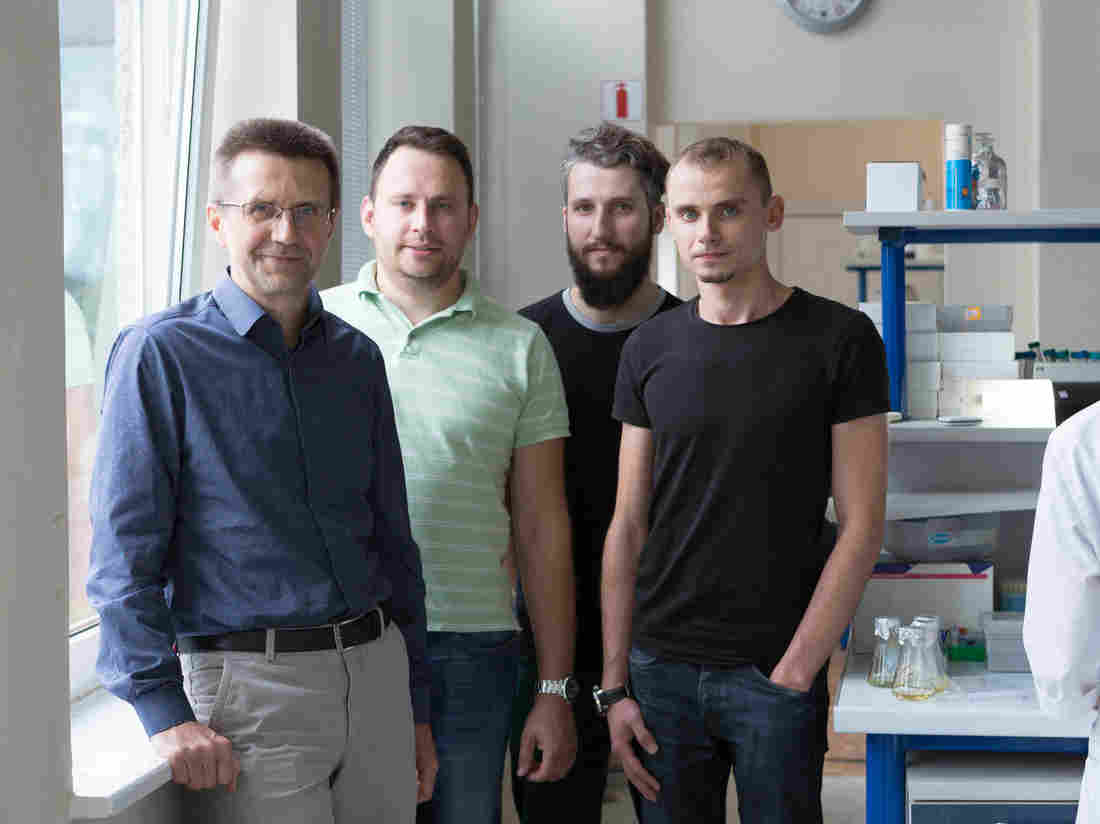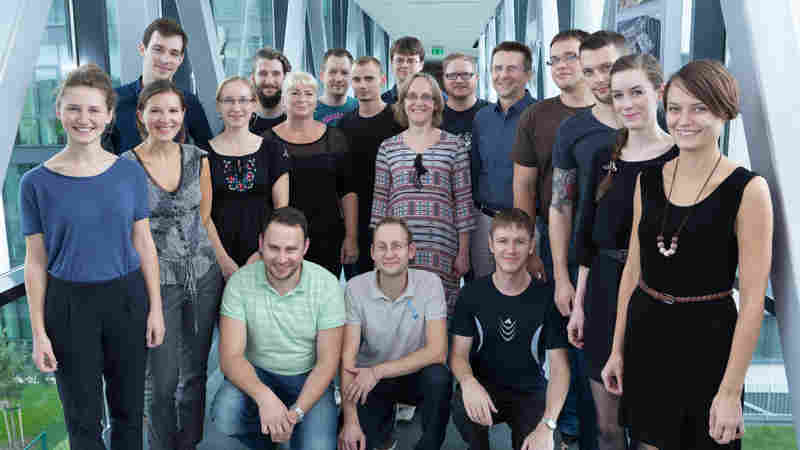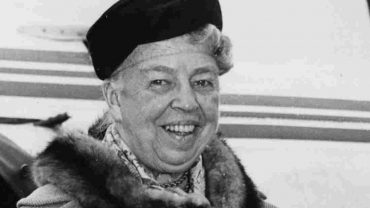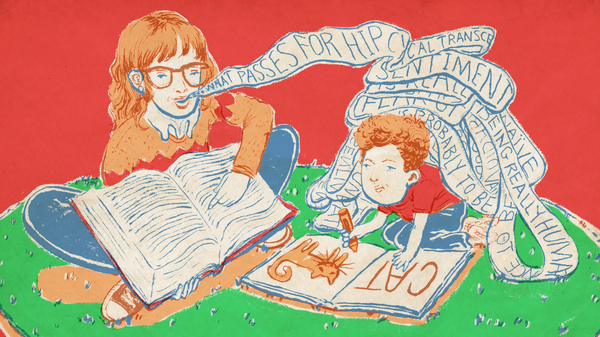Science Rewards Eureka Moments, Except When It Doesn't

Virginijus Siksnys, Giedrius Gasiunas, Tomas Sinkunas and Tautvydas Karvelis study CRISPR systems at the Institute of Biotechnology in Lithuania. Arunas Silanskas/Vilnius University Institute of Biotechnology hide caption
toggle caption
Arunas Silanskas/Vilnius University Institute of Biotechnology
Lots of people think this is how science works: A genius sits in a lab working late into the night and, finally — “Eureka!” After that come big prizes, and maybe even lucrative patents, right?
Discoveries are rarely so straightforward. A recent biotech advance that goes by the long, awkward acronym of CRISPR-Cas9 is a perfect case.
It’s a process that makes editing DNA seem as easy as fixing typos in an email, thanks to a molecule that cuts up DNA like a pair of scissors. Scientists figured out a way to use that scissor-tool in pretty much any organism, from mushrooms to human embryos.
Now, with patents and awards (maybe even a future Nobel Prize) hovering, the big question is: Who, exactly, invented this revolutionary method?
Jake Sherkow, who teaches intellectual property rights at New York Law School, says that’s literally a billion dollar question. It has to be answered.
“The stakes are very high,” says Sherkow, who is following the U.S. patent dispute. One side, Editas Medicine, has spent almost $15 million on this patent fight, he says. “Fifteen million dollars is a good measure of just how viciously the lawyers are litigating things on each side,” he says.
There are only a few big names that people generally associate with this invention and the patent dispute — Jennifer Doudna and Emmanuelle Charpentier are two. Feng Zhang is another. But many, many more scientists — and their graduate students — helped get CRISPR to this point. And many of them did so from much smaller labs in much smaller countries.
Virginijus Siksnys, a biochemist in Vilnius, Lithuania, is one of those people.
Siksnys was born in Lithuania and has worked there throughout his career, except for getting a doctorate at Moscow State University in Russia. When Siksnys was a grad student, Lithuania was still part of the Soviet Union, and he couldn’t leave because the borders were closed. He now leads a lab at the Institute of Biotechnology at Vilnius University, in Lithuania’s capital city.
On the day I visit, students and postdoctoral researchers are milling about working on experiments. Plants droop from a window sill and some fish trophies decorate a shelf. (“It’s pike, I think,” Siksnys explains. “One postdoc liked fishing very much, but his wife didn’t, so all his trophies went to the lab.”)
“They figured out several important pieces of this puzzle,” says Nathaniel Comfort, a historian of science and biomedicine at Johns Hopkins University. “The catch is that they weren’t the only ones to do that.”

Virginijus Siksnys’ large research team at the Vilnius University Institute of Biotechnology in Lithuania. Arunas Silanskas/Vilnius University Institute of Biotechnology hide caption
toggle caption
Arunas Silanskas/Vilnius University Institute of Biotechnology
In 2012, after years of hard work, Siksnys and his colleagues figured out how certain bacteria are able to cut and paste specific genes from other organisms. Even more importantly, Siksnys’ team found a way to control the process. They could get the CRISPR system to cut out any gene sequence they wanted. “It was very exciting,” says Giedrius Gasiunas, who was then a graduate student in Siksnys’ lab.
Siksnys and colleagues submitted their work to a top journal, Cell, writing that “These findings pave the way for the development of unique molecular tools for RNA-directed DNA surgery.”
Cell rejected the paper without review. Frustrated, the scientists then submitted their study to another journal, PNAS. It was accepted. But a month before the Siksnys paper came out, a similar study from another group working on CRISPR was published in the journal Science. The key authors on that paper were Jennifer Doudna with the University of California, Berkeley, and Emmanuelle Charpentier, who was then affiliated with Umea University in Sweden, and is now with the Max Planck Institute in Germany.
Both studies described how CRISPR works. But the researchers publishing in Science went a step further; they’d engineered a simpler version of CRISPR that would be more likely to work in many different organisms, including human cells.
And even though the group based in California and Sweden had submitted their paper after the Lithuanian group did, their paper came out first; Science had fast-tracked it to publication.
Siksnys and Gasiunas say being outraced to publication was disappointing, but not a total surprise. “[The] CRISPR field is very competitive,” Siksnys tells me, “and so you never know.”
That moment in 2012 proved to be a turning point for the technology.
“It went from this kind of obscure thing that looked like it might have promise, to this juggernaut that exploded across the biomedical scene,” says Comfort. “It was like a wildfire. Within about a year, year and a half, it was being done in almost any biomedical lab that you could think of.”
The names of the scientists on the Science study — Jennifer Doudna and Emmanuelle Charpentier — are now tightly linked with CRISPR, and they are contenders for the main U.S. patent. The other contenders, led by Feng Zhang, are based at the Broad Institute in Massachusetts. Virginijus Siksnys and Giedrius Gasiunas are rarely mentioned.
Comfort says that’s largely because patents and prizes set out to recognize discovery, but in many cases it can be a hairy mess just to define what the discovery really was. And sometimes, multiple groups make the same discovery at the same time.
For example, take the discovery and development of the hormone insulin as a medical treatment for type 1 diabetes. Back in the 1920s, injections of insulin harvested and purified from animals turned this form of the illness from a death sentence into a manageable disorder.
There was no doubt it was an important medical development. But Comfort says there was a bitter fight over what the pioneering “discovery” that led to the treatment was, let alone who was responsible for it.
“Was it the initial idea?” Comfort asks. “Was it the factual discovery of the insulin itself? Was it the ability to isolate it? Was it the ability to treat the first patient? Or was it the ability to scale it up into a medically useful compound?”
It’s proving just at brain-twisting to pick apart who “invented” the CRISPR-Cas9 system. There were people who found that certain bacteria were capable of cutting and pasting DNA; people who figured out why and how bacteria managed to do that; people who figured out how to harness that ability and use it for specific purposes and people who made the method into a ready-made tool.
“Few names will be remembered at the end, but there are a lot more people that contributed in a significant way to its development. It takes teamwork,” says Philippe Horvath, a molecular biologist who works with DuPont in the French village of Dangé-Saint-Romain in France. He estimates that a hundred or so researchers — himself included — were involved in getting CRISPR-Cas9 technology to where it is now.
In 2007, Horvath published a paper in Science that helped seed key findings about CRISPR in labs from Lithuania to Canada to California. But, to some extent, Horvath expects to be forgotten.
“I recognize that the real interest is in the gene editing aspect, and it’s possible that we’ll forget those who discovered the natural bacterial system and remember only the final developers of tools that allow this revolution,” says Horvath.
For now, Horvath and Siksnys say they’re content with the small amount of recognition they have received, including a recent prize from Harvard Medical School that they shared with other CRISPR scientists. Meanwhile, the race to build on those early findings continues.
Every day, Siksnys says, he checks to see what new papers have come out regarding CRISPR. Sometimes, the anticipation makes his hands shake a little, he says, “because you never know if someone already did what you are trying to publish.”
But, the field’s strong competition will not deter him from his work, he says. “This is what keeps me still in science — because you never know what will happen the next day, and that is really, really exciting.”



